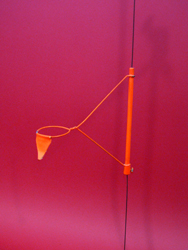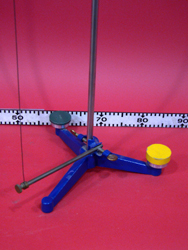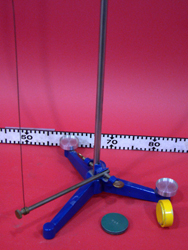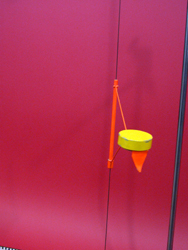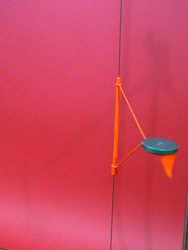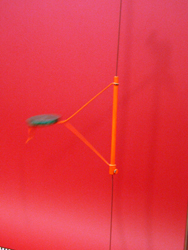|
Size: 1805
Comment:
|
← Revision 8 as of 2013-07-12 18:18:57 ⇥
Size: 2879
Comment: converted to 1.6 markup
|
| Deletions are marked like this. | Additions are marked like this. |
| Line 2: | Line 2: |
| ||<:30%>[:PiraScheme#Mechanics: Table of Mechanics Demonstration]||<:30%>[:MEEquipmentList: List of Mechanics Equipment & Supplies]||<:30%>[:Demonstrations:Lecture Demonstrations]|| | ||<:30%>[[PiraScheme#WavesSound| Table of Waves and Sound Demonstration]]||<:30%>[[MEEquipmentList| List of Mechanics Equipment & Supplies]]||<:30%>[[Demonstrations|Lecture Demonstrations]]|| |
| Line 7: | Line 7: |
| Oscillations, [:Oscillations#Pendula: 3A10. Pendula] | Oscillations, [[Oscillations#Pendula| 3A10. Pendula]] |
| Line 10: | Line 10: |
| * '''Cabinet:''' [:MechanicsCabinet:Mechanic (ME)] * '''Bay:''' [:MechanicsCabinetBayA12:(A12)] |
* '''Cabinet:''' [[MechanicsCabinet|Mechanic (ME)]] * '''Bay:''' [[MechanicsCabinetBayA12|(A12)]] |
| Line 14: | Line 14: |
| attachment:TorsionPendulum01-400.jpg | {{attachment:TorsionPendulum01-400.jpg}} |
| Line 22: | Line 22: |
| ||Torsion Pendulum||[:MechanicsCabinetBayA12: ME, Bay A12, Shelf #T]|| || | ||Torsion Pendulum||[[MechanicsCabinetBayA12| ME, Bay A12, Shelf #T]]|| || |
| Line 31: | Line 31: |
| 1. List steps for setup then procedure. 1. ... |
1. Place the apparatus on the lecture bench. 1. Displace the orange "flag" in a circular direction horizontally and release. 1. Add one of the weights (grey or yellow) to the flag as pictured below and and again set the flag into oscillatory motion. Note the difference in the period of oscillation for each configuration. |
| Line 40: | Line 41: |
| Discuss the physics behind the demonstration, explaining some of the various steps of the demonstration when appropriate. | In a torsion pendulum, the restoring force is provided by the torsion in the wire that the mass is connected to. The period of oscillation is dependent upon the moment of inertia of the system and the torsion spring constant of the wire (assuming very little dampening). Mathematically, the period is given by |
| Line 42: | Line 43: |
| ||attachment:TorsionPendulum02-250.jpg||attachment:TorsionPendulum03-250.jpg||attachment:TorsionPendulum04-250.jpg||attachment:TorsionPendulum05-250.jpg|| ||attachment:TorsionPendulum10-250.jpg||attachment:TorsionPendulum11-250.jpg||attachment:TorsionPendulum12-250.jpg||attachment:TorsionPendulum13-250.jpg|| |
T = 2π * Sqrt[I/κ] ≈ 2π * R * Sqrt[M/κ] where I is the moment of inertia, κ is the torsion spring constant, M is the mass of our "bob", and R is the radial distance of the mass from the wire. For our system, the torsion spring constant is constant throughout the demonstration. The distance of the mass from the wire is constant. Thus, when we add mass to the system, I is increased resulting in an increase in the period of oscillation. ||{{attachment:TorsionPendulum02-250.jpg}}||{{attachment:TorsionPendulum03-250.jpg}}||{{attachment:TorsionPendulum04-250.jpg}}||{{attachment:TorsionPendulum05-250.jpg}}|| ||{{attachment:TorsionPendulum11-250.jpg}}||{{attachment:TorsionPendulum12-250.jpg}}||{{attachment:TorsionPendulum16-250.jpg}}||{{attachment:TorsionPendulum13-250.jpg}}|| |
| Line 46: | Line 52: |
| * [https://www.youtube.com/user/LectureDemostrations/videos?view=1 Lecture Demonstration's Youtube Channel] | * [[https://www.youtube.com/user/LectureDemostrations/videos?view=1|Lecture Demonstration's Youtube Channel]] |
| Line 50: | Line 56: |
| * [https://en.wikipedia.org/wiki/Oscillation Wikipedia - Oscillation] * [https://en.wikipedia.org/wiki/Pendulum Wikipedia - Pendulum] |
* [[https://en.wikipedia.org/wiki/Oscillation|Wikipedia - Oscillation]] * [[https://en.wikipedia.org/wiki/Pendulum|Wikipedia - Pendulum]] * [[https://en.wikipedia.org/wiki/Torsion_pendulum#Torsion_balance|Wikipedia - Torsion Pendulum]] |
| Line 53: | Line 60: |
[:Instructional:Home] |
[[Instructional|Home]] |
Torsion Pendulum, 3A10.30
Topic and Concept:
Oscillations, 3A10. Pendula
Location:
Cabinet: Mechanic (ME)
Bay: (A12)
Shelf: #T
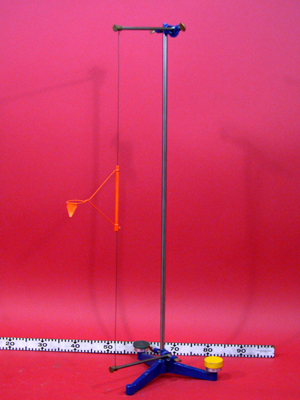
Abstract:
Weight is added to a torsion pendulum to decrease the period of oscillations.
Equipment |
Location |
ID Number |
|
|
|
Torsion Pendulum |
|
Important Setup Notes:
- N/A
Setup and Procedure:
- Place the apparatus on the lecture bench.
- Displace the orange "flag" in a circular direction horizontally and release.
- Add one of the weights (grey or yellow) to the flag as pictured below and and again set the flag into oscillatory motion. Note the difference in the period of oscillation for each configuration.
Cautions, Warnings, or Safety Concerns:
- N/A
Discussion:
In a torsion pendulum, the restoring force is provided by the torsion in the wire that the mass is connected to. The period of oscillation is dependent upon the moment of inertia of the system and the torsion spring constant of the wire (assuming very little dampening). Mathematically, the period is given by
T = 2π * Sqrt[I/κ] ≈ 2π * R * Sqrt[M/κ]
where I is the moment of inertia, κ is the torsion spring constant, M is the mass of our "bob", and R is the radial distance of the mass from the wire. For our system, the torsion spring constant is constant throughout the demonstration. The distance of the mass from the wire is constant. Thus, when we add mass to the system, I is increased resulting in an increase in the period of oscillation.
|
|
|
|
|
|
|
|
Videos:
References:
